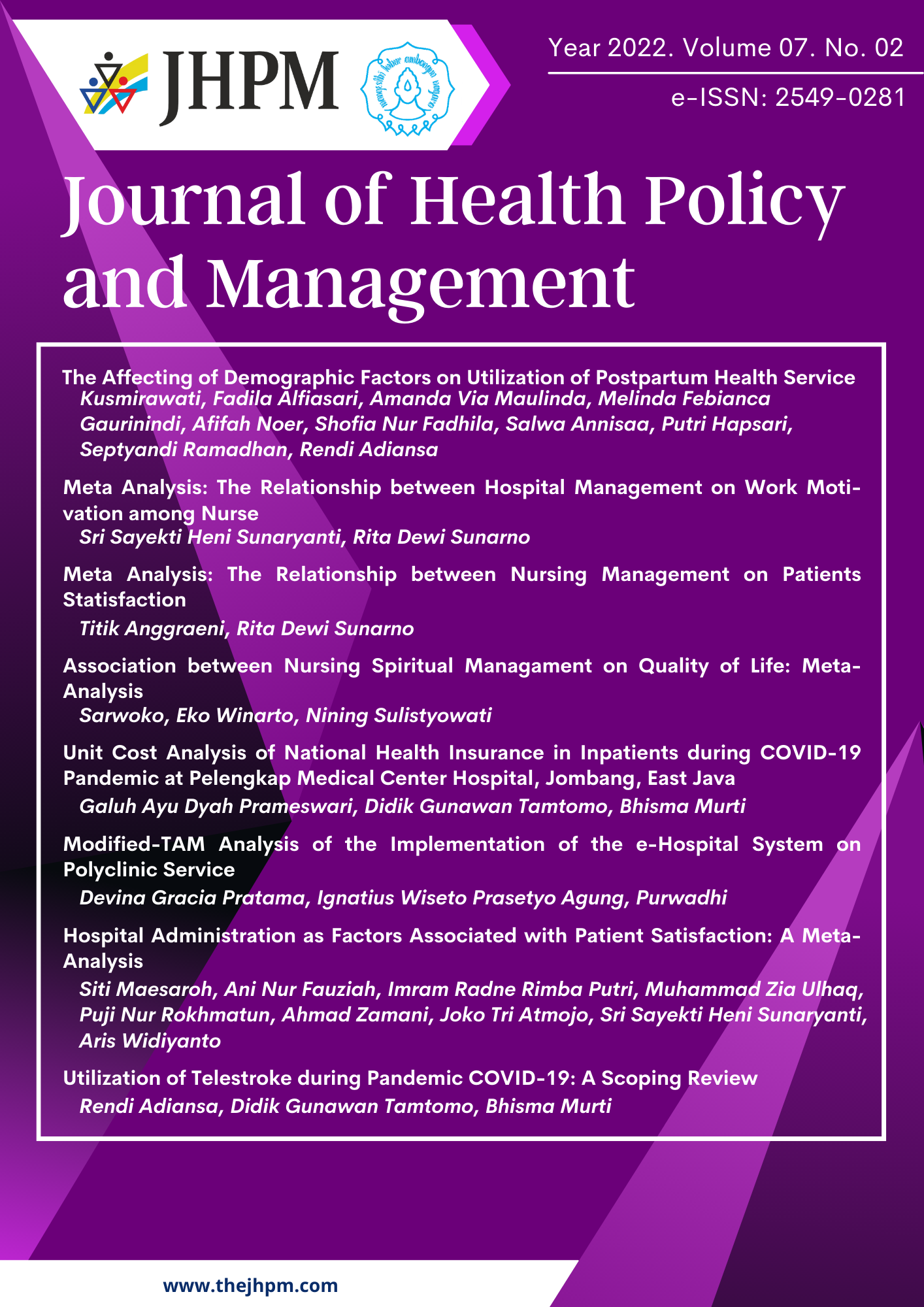The Affecting of Demographic Factors on Utilization of Postpartum Health Service
Abstract
Background: Based on research states that the prevalence rate of complete postpartum visits
(KF) in Indonesia is 37%, where this figure has increased from 2013 of 32.1%. The problem with
the achievement of postpartum visits in Indonesia is that the underdeveloped areas mentioned in
Presidential Decree Number 63 of 2020, namely North Sumatra, Central Sulawesi, Maluku, Papua
and West Papua, occupy the bottom 6 provinces in the complete postnatal visit. The province of
West Papua is the region with the lowest KF coverage rate in Indonesia.
Subjects and Method: Metaanalysis conducted using the PRISMA systematic guidelines.
Population= puerperium mother, Intervention= Urban, Comparison= Rural, Outcome= Utility of
postnatal health service. The process of searching for articles was carried out between 2005 and
2021 using a database search engine consisting of; PubMed, Science Direct, Springer Link, and
Google Scholar. Based on the database search, there were ten articles that met the criteria with a
crosssectional design and observational studies and research that discussed demographic factors
(urban & rural) on health care facilities.
Results: The results of the analysis had high heterogeneity between studies I2= 94%, so that the
Random Effect Model was used. Postnatal mothers living in urban areas increased by 1.48 times in
utilizing postnatal care health services compared to postnatal mothers living in rural areas.
however it was not statistically significant (SMD= 1.48; 95% CI= 0.90 to 2.44; p= 0.012).
Conclusion: Postpartum women who live in urban areas use postpartum health services more
than postpartum women who live in rural areas.
Keywords: postpartum, postnatal visit, demographic factors
Correspondence: Kusmirawati. Masters Program in Public Health, Universitas Sebelas Maret. Jl. Ir. Sutami 36A,
Surakarta 57126, Central Java. Email: rendiadiansa@student.uns.ac.id Mobile Number: 08816008735.
Journal of Health Policy and Management (2022), 07(03): 176-184
https://doi.org/10.26911/thejhpm.2022.07.03.01
References
Abebo TA, Tesfaye DJ (2018). Postnatal care utilization and associated factors among women of reproductive age Group in Halaba Kulito Town, Southern Ethiopia. Arch Public Health. 76(1): 1–10. https://doi.org/10.1186/s1369001802566.
Alemayehu M, Gebrehiwot TG, Medhanyie AA, Desta A, Alemu T, Abrha A, Godefy H (2020). Utilization and factors associated with antenatal, delivery and postnatal Care Services in Tigray Region, Ethiopia: A communitybased crosssectional study. BMC Pregnancy
and Childbirth, 20(1): 1–13. https://doi.org/10.1186/s12884020030316
Ayele BG, Woldu MA, Gebrehiwot HW, GebreEgziabher EG, Gebretnsae H, Hadgu T, Abrha AA, Medhanyie AA (2019). Magnitude and determinants for place of postnatal care utilization among mothers who delivered at home in Ethiopia: A multinomial analysis from the 2016 Ethiopian demographic health survey. Reproductive Health, 16(1): 1–10. https://doi.org/10.1186/s1297801908182.
Chhetri S, Shah R, Rajbanshi L (2020). Factors associated with utilization of complete postnatal care service in Baglung Municipality, Nepal. International Journal of Reproductive Medicine. 1–8. https://doi.org/10.1155/2020/2892751.
Dagnew GW, Asresie MB, Fekadu GA, Gelaw YM (2020). Modern contraceptive use and factors associated with use among postpartum women in Ethiopia; Further analysis of the 2016 Ethiopia demographic and health survey data. BMC Public Health, 20 (1): 1–10. https://doi.org/10.1186/s12889020088026
Kemenkes (2014). Infodatin Situasi Kesehatan Ibu. Jakarta: Kemenkes. https://pusdatin.kemkes.go.id.
Khanal V, Adhikari M, Karkee R, Gavidia T (2014). Factors associated with the utilisation of postnatal care services among the mothers of Nepal: Analysis of Nepal Demographic and Health Survey 2011. BMC Women’s Health, 14(1): 1–13. https://doi.org/10.1186/147268741419.
Khankhell RMK, Ghotbi N, Hemat S (2020). Factors influencing utilization of postnatal care visits in Afghanistan. Nagoya Journal of Medical Science, 82(4): 711–723. https://doi.org/10.18999/nagjms.82.4.711.
Shitie A, Assefa N, Dhressa M, Dilnessa T (2020). Completion and factors associated with maternity continuum of care among mothers who gave birth in the last one year in Enemay District, Northwest Ethiopia. Journal of Pregnancy. https://doi.org/10.1155/2020/7019676.
Soressa U, Mamo A, Hiko D, Fentahun N (2016). Prevalence, causes and management outcome of intestinal obstruction. BMC Surgery. 16(8): 18. https://doi.org/10.1186/s1289301601505.
Tsegaye B, Amare B, Reda M (2021). Prevalence and factors associated with immediate postnatal care utilization in ethiopia: Analysis of Ethiopian demographic health survey 2016. International Journal of Women’s Health, 13: 257–266. https://doi.org/10.2147/IJWH.S294058.






